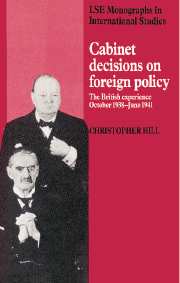Book contents
- Frontmatter
- Contents
- List of figures
- List of tables
- Acknowledgements
- Preface
- 1 Cabinets, foreign policies and case-studies
- 2 Constructing the Polish Guarantee, 15–31 March 1939
- 3 The Soviet question, April–August 1939
- 4 Entry into war, 1–3 September 1939
- 5 Reacting to the ‘peace offensive’, October 1939
- 6 To continue alone? May–July 1940
- 7 The longer term: War Aims and other committees, October 1940–June 1941
- 8 Decision-making in Cabinet
- Appendix 1 The Chamberlain Cabinet, 31 October 1938–3 September 1939
- Appendix 2 Attendance at the Foreign Policy Committee of the Cabinet, 14 November 1938–25 August 1939
- Appendix 3 Neville Chamberlain's statement in the House of Commons, 12 October 1939
- Appendix 4 Lord Halifax's paper for the War Aims Committee, October 1940
- Appendix 5 Anthony Eden's speech at the Mansion House, 29 May 1941 (extract)
- Notes
- Bibliography
- Index
- LSE MONOGRAPHS IN INTERNATIONAL STUDIES
Appendix 2 - Attendance at the Foreign Policy Committee of the Cabinet, 14 November 1938–25 August 1939
Published online by Cambridge University Press: 02 February 2010
- Frontmatter
- Contents
- List of figures
- List of tables
- Acknowledgements
- Preface
- 1 Cabinets, foreign policies and case-studies
- 2 Constructing the Polish Guarantee, 15–31 March 1939
- 3 The Soviet question, April–August 1939
- 4 Entry into war, 1–3 September 1939
- 5 Reacting to the ‘peace offensive’, October 1939
- 6 To continue alone? May–July 1940
- 7 The longer term: War Aims and other committees, October 1940–June 1941
- 8 Decision-making in Cabinet
- Appendix 1 The Chamberlain Cabinet, 31 October 1938–3 September 1939
- Appendix 2 Attendance at the Foreign Policy Committee of the Cabinet, 14 November 1938–25 August 1939
- Appendix 3 Neville Chamberlain's statement in the House of Commons, 12 October 1939
- Appendix 4 Lord Halifax's paper for the War Aims Committee, October 1940
- Appendix 5 Anthony Eden's speech at the Mansion House, 29 May 1941 (extract)
- Notes
- Bibliography
- Index
- LSE MONOGRAPHS IN INTERNATIONAL STUDIES
Summary
The basis for the calculations made in chapter 3, pp. 70–84, is set out below. Original data is available in Figure 1 and Table 2, pp. 74 and 80), and all figures are corrected to one decimal place.
(1) Attendance of ministers
Average attendance for Period 1 (FP(36) 32–42, 14 November 1938–11 April 1939, including Anderson, present for one item only at FP(36) 33 = 8.1 Ministers per meeting (89/11).
Average attendance for Pmod 2 (FP(36) 43–61,19 April–25 August 1939, but excluding Meetings 46,51,52,55 and 61, which were not concerned with the Soviet issue) = 9.9 Ministers per meeting (138/14).
Runciman was absent abroad for the period 27 March–19 May 1939
inclusive, i.e. eleven meetings, of which one in the second period was not concerned with the USSR. Five of his absences fall into each period. Adding 5 to the total for each period would alter the averages to 8.5 and 10.2 respectively, a difference of 1.7 rather than 1.8. Runciman therefore cancels out.
Chatfleld and Morrison did not join the Committee until 8 February 1939. In order to adjust the figures for the weighting in favour of Period 2 that would otherwise occur we need to add (on the assumption of nearly full attendance for both over 5 missed meetings), say, 9 to the total attendances for Period 1. This leaves an average attendance of 8.9, as compared to 9.9 for Period 2. So the true increase in ministerial attendance from Period 1 to Period 2 is 9.9 – 8.9 = 1.0.
- Type
- Chapter
- Information
- Cabinet Decisions on Foreign PolicyThe British Experience, October 1938–June 1941, pp. 250 - 251Publisher: Cambridge University PressPrint publication year: 1991
- 1
- Cited by



